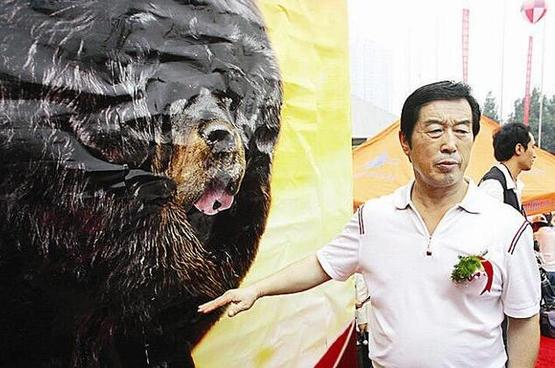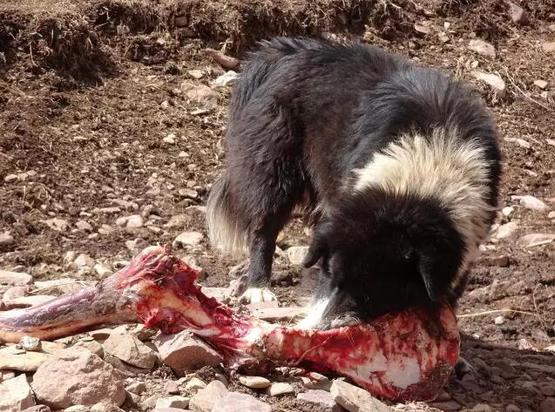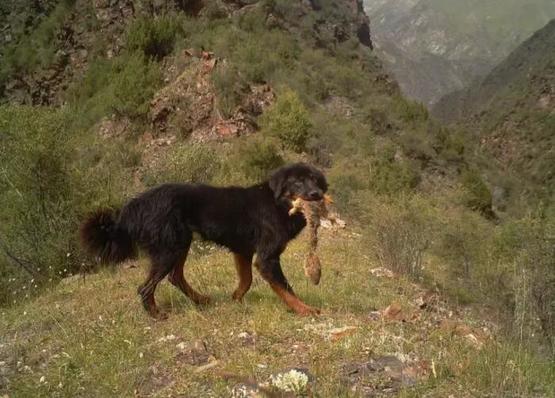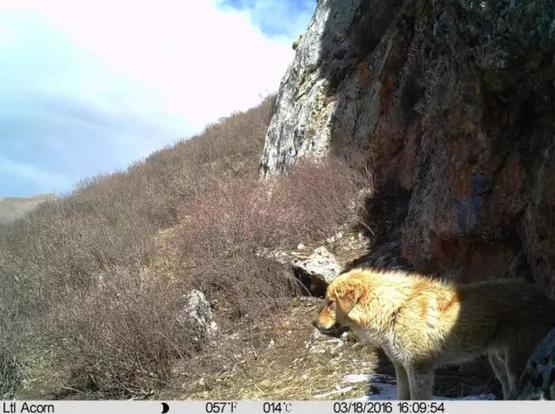这是一张来自藏区的照片。你看到了什么?
 图片来自:山水自然保护中心
图片来自:山水自然保护中心
被困在山头的是一只雪豹,而包围住它的是一群流浪的藏獒。
也许这张照片会冠以“趣图”之名在社交网络上流传,可它背后的事情一点都不有趣。这是今天藏区的日常,但却是可悲的日常——曾经深受藏区人民珍视的藏獒,如今正在大量涌入当地野生环境,威胁野生动物的生存。除了雪豹,牧民还拍到过流浪狗围攻棕熊和狼的视频。通过研究藏獒与野生动物的粪便发现,流浪的藏獒也会捕食藏狐等中小型食肉动物。
但问题是,这些藏獒从哪儿来?
藏獒崩盘,制造大量流浪狗
青藏高原上越来越多的流浪狗,是同藏獒市场的兴衰变化相关的。以前,驯养藏獒的成本非常高,一般只有僧人、农奴主等上层人士才能负担。在很长的一段时间中,藏獒都是禁止被买卖的奢侈品,藏獒的数量一直不多。
 有藏獒血统的流浪狗 图片来源:山水自然保护中心
有藏獒血统的流浪狗 图片来源:山水自然保护中心
进入二十一世纪,藏獒突然变成了一个致富神话。“在路边要饭的乞丐,”因为别人送的一条藏獒“赚了钱,娶了媳妇,有了家”,类似的致富故事在藏獒之乡玉树藏族自治州还有很多。这种数量稀少,体型高大,生性凶猛的狗在比赛场上屡获关注,加上名人效应和商家的炒作,藏獒价格在近30年的时间里,从最初的几百元,一直涨到2005年的10万,乃至上千万元。
 中国藏獒俱乐部主席马俊仁 图片来源:法制晚报
中国藏獒俱乐部主席马俊仁 图片来源:法制晚报
飞涨的价格促进养殖业快速发展,藏獒数量急剧上升,市场却难以消化。“控犬”政策、袭人事件以及资本的撤出都使藏獒经济下滑,价格快速回落。藏獒行业从2012年起便进入了前所未有的寒冬期,天价藏獒沦为火锅配料。越来越多的藏獒惨遭抛弃。
藏獒流落野外之后数量不降反增。青藏高原当地有不杀生的信仰,寺庙中的和尚会喂食流浪动物,很多流浪狗便聚集在寺庙周围。它们适应力强,繁殖快,数量不断增加。大批流浪狗涌入自然环境,捕食牧民的家畜,科学家发现在一些养殖家畜的地区,流浪狗已经取代狼成为导致家畜死亡的主要原因。更糟糕的是,流浪狗的存在会给当地生态环境造成严重威胁。
 正在啃食动物尸骨的流浪狗 图片来源:山水自然保护中心
正在啃食动物尸骨的流浪狗 图片来源:山水自然保护中心
最大受害者是当地野生动物
流浪狗的捕食行为会直接影响当地野生动物的数量。一方面流浪狗会直接攻击和捕食当地野生动物,比如以色列南部的山瞪羚由于流浪狗的捕食数量明显下降;新西兰的一只狗在6周内杀死了500只几维鸟,而当地几维鸟种群仅有900只。另一方面,群居生活的流浪狗与野生动物的竞争中更占优势,食肉动物组成小团体后,捕猎及对战的成功率大于单个个体,野生的埃塞俄比亚狼就由于高密度流浪狗的竞争而出现明显的数量下降。
 三江源地区拍摄到的叼着野生旱獭的流浪狗 图片来源:山水自然保护中心
三江源地区拍摄到的叼着野生旱獭的流浪狗 图片来源:山水自然保护中心
流浪狗还有可能把疾病带入野生动物的栖息地。犬科、猫科、鬣狗科、海豹科、鼬科、灵猫科和浣熊科动物都有可能感染流浪狗所携带的疾病而造成数量下降。1994年,在非洲的塞伦盖蒂,出现了大量非洲野狗、狮子、鬣狗和豺等动物感染狂犬病和犬瘟的事件。在藏区,科研人员已经在雪豹的粪便中,发现了来自狗身上的线虫、吸虫、绦虫和球虫等寄生虫。
 雪豹栖息地红外相机拍到的流浪狗 图片来源:山水自然保护中心
雪豹栖息地红外相机拍到的流浪狗 图片来源:山水自然保护中心
更可怕的是,如果不加干预,流浪狗的数量只会越来越多。不同于野生动物,流浪狗更容易获得人类食物,即“人类津贴效应”。充足的食物导致狗的数量增多,对野生动物的捕食也增多,而野生猎物数量下降却不会明显减少流浪狗的食物来源。这种负反馈的缺乏可能最终会驱使野生动物走向灭亡。
这些潜在危害在藏区是否已经发生?为了进一步研究藏区流浪狗对野生动物产生的威胁,我们计划通过红外相机和给流浪狗携带GPS定位的方式来查看其与当地野生食肉动物在活动节律和家域上的重叠情况。另外,我们还收集流浪狗和野生食肉动物的粪便样品研究其食性组成和疾病情况。
 头顶GPS的研究人员 图片来源:山水自然保护中心
头顶GPS的研究人员 图片来源:山水自然保护中心
如何解决?
首先需要在不违反当地宗教习俗和信仰的情况下进行绝育和收容。流浪狗种群数量越多、活动范围越大,它们对野生动物的影响则越大。绝育可以有效控制流浪狗出生率,建立流浪狗收容所进行统一管理或转移可以控制流浪狗的活动范围。
目前,在西藏和青海部分地区已经开始和计划建立流浪狗收容所,但如何经营仍是大问题。以拉萨流浪犬收养中心为例,目前已经收养6000多只流浪狗,数量仍在持续增多,远超过犬舍所能承载的预期数量,每年拨款100多万元,但仍难以持续。
另外,控制人类垃圾,减少流浪狗的饮食来源,增强养狗家庭,尤其是少数拥有大量狗的家庭对圈养狗的责任心,积极配合免疫工作,都是解决流浪狗问题的必要手段。
说到底,流浪狗也只是在适应自然的夹缝中艰难求生的受害者之一。为了生态平衡、为了野生动物、为了狗、也为了我们自己,请对自己曾经、现在和未来的选择做更多的深思。不要因为我们的一己私心,对其他生命带来不必要的痛苦。
(本文转自山水自然保护中心公众号,微信号:SSbaohu,内容有改动,编辑:王劈柴)
参考文献
- Hughes, J. & Macdonald, D. W. A review of the interactions between free-roaming domestic dogs and wildlife. BiolConserv 157, 341-351, doi:10.1016/j.biocon.2012.07.005 (2013).
- Taborsky, M. Kiwis and dog predation: observations in Waitangi State Forest. Notornis 35, 197-202 (1988).
- Corbett, L. K. dingo in Australia and Asia. (UNSW Press, 1995).
- Boitani, L., Francisci, F., Ciucci, P. &Andreoli, G. 1C Population biology and ecology of+ S feral dogs in central Italy. The domestic dog: Its evolution, behaviour, and interactions with people, 217 (1995).
- Atickem, A., Bekele, A. & Williams, S. Competition between domestic dogs and Ethiopian wolf (Canissimensis) in the Bale Mountains National Park, Ethiopia. African Journal of Ecology 48, 401-407 (2010).
- Cozza, K., Fico, R., Battistini, M.-L. & Rogers, E. The damage-conservation interface illustrated by predation on domestic livestock in central Italy. BiolConserv 78, 329-336 (1996).
- Suryawanshi, K. R., Bhatnagar, Y. V., Redpath, S. & Mishra, C. People, predators and perceptions: patterns of livestock depredation by snow leopards and wolves. Journal of Applied Ecology 50, 550-560 (2013).
- Echegaray, J. &Vilà, C. Noninvasive monitoring of wolves at the edge of their distribution and the cost of their conservation. Animal Conservation 13, 157-161 (2010).
- Sundqvist, A.-K., Ellegren, H. &Vilà, C. Wolf or dog? Genetic identification of predators from saliva collected around bite wounds on prey. Conservation Genetics 9, 1275-1279 (2008).
- Daniels, T. J. &Bekoff, M. Population and social biology of free-ranging dogs, Canisfamiliaris. Journal of Mammalogy 70, 754-762 (1989).
- Butler, J. R. A., du Toit, J. T. & Bingham, J. Free-ranging domestic dogs (Canisfamiliaris) as predators and prey in rural Zimbabwe: threats of competition and disease to large wild carnivores. BiolConserv 115, 369-378, doi:10.1016/s0006-3207(03)00152-6 (2004).
- Manor, R. &Saltz, D. Impact of human nuisance disturbance on vigilance and group size of a social ungulate. Ecological Applications 13, 1830-1834 (2003).
- Butler, J. &Toit, J. Diet of free‐ranging domestic dogs (Canisfamiliaris) in rural Zimbabwe: implications for wild scavengers on the periphery of wildlife reserves. Animal Conservation 5, 29-37 (2002).
- Laurenson, K., Shiferaw, F., SilleroZubiri, C., SilleroZubiri, C. & Macdonald, D. The Ethiopian wolf: status survey and conservation action plan. Disease, Domestic Dogs and the Ethiopian Wolf: the Current Situation (Eds C. SilleroZubiri& DW Macdonald), 32 (1997).
- Aiyadurai, A. &Jhala, Y. V. Foraging and habitat use by golden jackals (Canis aureus) in the Bhal Region, Gujarat, India. JOURNAL-BOMBAY NATURAL HISTORY SOCIETY 103, 5 (2006).
- Vanak, A. T., Gompper, M. &Belsare, A. Survey of Disease Prevalence in Free-ranging Domestic Dogs and Possible Spill-over Risk to Wildlife. Rufford Small Grants Foundation, 1-13 (2007).
- Funk, S., Fiorello, C., Cleaveland, S. &Gompper, M. The role of disease in carnivore ecology and conservation. CONSERVATION BIOLOGY SERIES-CAMBRIDGE-, 443-466 (2001).
- Cleaveland, S. et al. The conservation relevance of epidemiological research into carnivore viral diseases in the Serengeti. Conservation Biology 21, 612-622 (2007).
- Laurenson, K. et al. Disease as a threat to endangered species: Ethiopian wolves, domestic dogs and canine pathogens. Animal Conservation 1, 273-280 (1998).
- Deem, S. L., Spelman, L. H., Yates, R. A. &Montali, R. J. Canine distemper in terrestrial carnivores: a review. Journal of Zoo and Wildlife medicine 31, 441-451 (2000).
- Torres, P. & Prado, P. Domestic dogs in a fragmented landscape in the Brazilian Atlantic Forest: abundance, habitat use and caring by owners. Brazilian Journal of Biology 70, 987-994 (2010).
- Fryxell, J. M., Sinclair, A. R. &Caughley, G. Wildlife ecology, conservation, and management. (John Wiley & Sons, 2014).
- White, P. C. & Ward, A. I. Interdisciplinary approaches for the management of existing and emerging human–wildlife conflicts. Wildlife Research 37, 623-629 (2011).
- Vanak, A. T. &Gompper, M. E. DogsCanisfamiliarisas carnivores: their role and function in intraguild competition. Mammal Review 39, 265-283, doi:10.1111/j.1365-2907.2009.00148.x (2009).
- Bögel, K. &Meslin, F. Economics of human and canine rabies elimination: guidelines for programme orientation. Bulletin of the World Health Organization 68, 281 (1990).
- Coleman, P. G. & Dye, C. Immunization coverage required to prevent outbreaks of dog rabies. Vaccine 14, 185-186 (1996).
- Haydon, D. et al. Low-coverage vaccination strategies for the conservation of endangered species. Nature 443, 692-695 (2006).
- Vial, F., Cleaveland, S., Rasmussen, G. & Haydon, D. Development of vaccination strategies for the management of rabies in African wild dogs. BiolConserv 131, 180-192 (2006).
- Gompper, M. E. Free-ranging dogs and wildlife conservation. (Oxford University Press, 2013).
- 蔡毅,藏獒市场神话破灭。青年商旅报纸,2015年8月28日07版。http://qnsl.cyol.com/html/2015-08/28/nw.D110000qnslb_20150828_1-07.htm
- 孔迪,藏獒市场泡沫破裂:曾经数十万现在几十元一只。新文化报,2015年4月27日。
